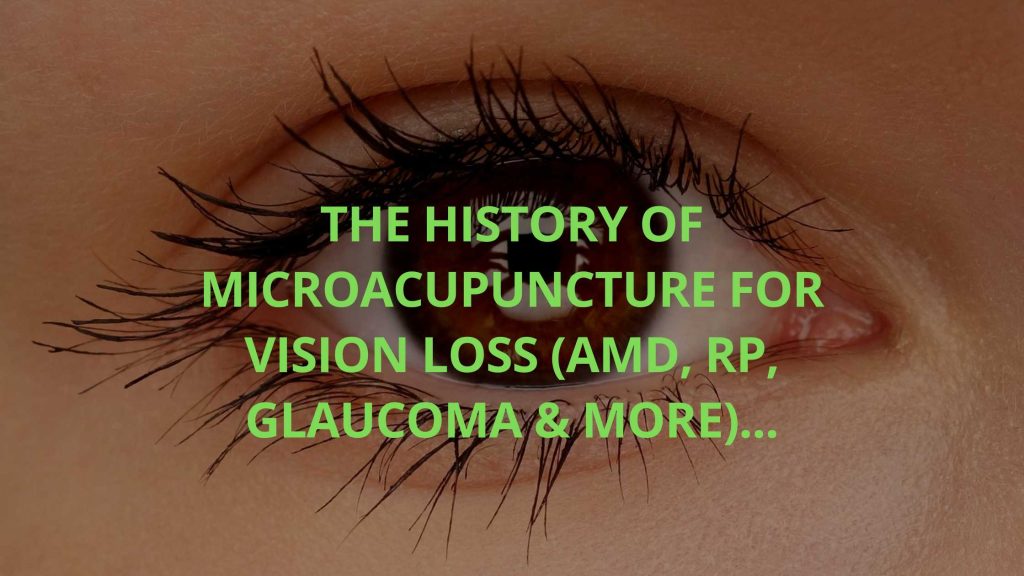The history of microacupuncture for degenerative eye issues like macular degeneration, retinitis pigmentosa, stargardt’s, glaucoma, and essentially any issue of the retina and optic nerve is one of bold innovation within the ancient art of acupuncture, where practitioners have honed ultra-precise techniques to target stubborn conditions like degenerative eye diseases. Emerging in the late 20th century, microacupuncture builds on traditional Chinese medicine’s meridian systems but zooms in on “microsystems”—tiny body maps that mirror and influence the whole organism. This approach has offered renewed hope for patients with vision loss from conditions such as age-related macular degeneration (AMD), retinitis pigmentosa (RP), glaucoma, diabetic retinopathy, and Stargardt’s disease. By stimulating blood flow, reducing inflammation, and promoting neural repair without ever needling near the eyes, MicroAcupuncture has evolved into a safe, non-invasive therapy backed by decades of clinical observation and emerging research.
Foundational Roots: The Bio-Holographic Vision of ECIWO
The conceptual bedrock of microacupuncture lies in the 1970s work of Chinese physician Dr. Yingqing Zhang, who introduced the ECIWO (Embryo Containing the Information of the Whole Organism) theory in 1973. Drawing from embryology and holography, Zhang proposed that certain body points—much like a hologram—encode and affect the entire body’s blueprint. This “bio-holographic” idea revolutionized acupuncture by shifting focus from broad meridians to localized microsystems, where stimulating a small area could influence distant organs, including the eyes. Initially applied to cancer treatment, ECIWO’s principles quickly inspired targeted therapies for complex conditions, laying the groundwork for modern microacupuncture’s precision in vision care. Zhang’s framework emphasized the body’s innate self-healing potential, a theme that would echo through subsequent developments.
Pioneering MicroAcupuncture: Freddy Dahlgren and the Birth of MicroAcupuncture
The practical leap into eye-specific microacupuncture came in Denmark during the early 1980s, spearheaded by physician Dr. Freddy Dahlgren. In 1984, while treating chronic pain and neurological issues, Dahlgren serendipitously discovered a set of ultra-specific acupuncture points that dramatically improved vision in patients with degenerative eye diseases. These “MicroAcupuncture,” on the hands and feet, bypassed traditional acupuncture points and are not something taught in school.
Dahlgren’s system, simply called MicroAcupuncture, was rigorously tested through thousands of cases. By the late 1980s,This protocol proved especially effective for slowing progression in AMD and RP, with patients reporting stabilized or improved central vision.
MicroAcupuncture Comes to America: Dr. Per Otte’s
Building directly on Dahlgren’s foundation, Danish acupuncturist Dr. Per Otte joined the effort in the late 1980s after graduating from the Scandinavian School of Acupuncture in 1988. Otte, who trained under Dahlgren
By the 1990’s Per Otte came to America and brought the MicroAcupuncture system here. His clinic treated thousands of patients for degenerative eye issues. Per Otte did allow a handful of practitioners to learn the MicroAcupuncture system, but all they were ever shown was a once size fits all protocol.
A Parallel Revolution: John Boel Sr. and AcuNova’s Joint-Focused Breakthrough
Running concurrently in Denmark, acupuncturist John Boel Sr. forged his own path in the mid-1980s, developing AcuNova (short for “acupuncture nova,” or new acupuncture) as a complementary microsystem. Starting eye treatments in 1987, Boel identified novel points around the body’s finger and toe joints areas.
Boel’s clinic in Denmark has treated thousands of eye patients with remarkable results in RP and glaucoma
Modern Innovations: Dr. Josh Hanson The Next Generation of MicroAcupuncture
Advancing this legacy into the 21st century, Dr. Josh Hanson, DACM, a Tampa based MicroAcupuncture practitioner, has pioneered advancements in MicroAcupuncture protocols.
A standout innovation is Dr.Hanson’s in house developed visual field scanning using white noise perimetry – a rapid, noise-filtered method that overlays random static (like TV snow) on a field to highlight scotomas (areas where vision is missing) more quickly than standard automated visual field testing machines.
Developed by him for his clinic (and free to the world – freevisualfieldtest.com), this tool allows us to measure baselines defects pre-treatment and tracks shifts post-protocol. By doing so, Dr. Hanson can tailor your treatment to EXACTLY what you need.
His approach demystifies acupuncture’s effects, grounding them in physiology: needle stimulation at MicroAcupuncture triggers localized neural signaling that ramps up mitochondrial ATP production, enhances microcirculation, and reduces inflammatory cytokines, all without invoking any supernatural “energy” flows. Instead, it’s about hacking the body’s biochemistry to support cellular repair.
By quantifying progress objectively, Dr. Hanson refines point selections in real-time, ensuring protocols evolve with each patient’s neural and vascular response.
From Zhang’s holographic epiphany to Dr.Hanson’s neuro-cellular integrations, MicroAcupuncture is one of the ONLY tools available for these progressive degenerative eye issues. If you’re exploring this for yourself or a loved one, you can CALL US AT 813-534-031 to see how we can help.


